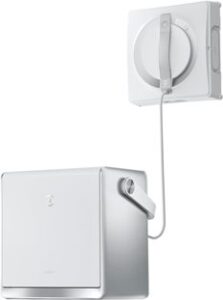Amazing Death Defying Window Cleaning Robots Coming Soon To Denver

What is a Window Cleaning Robot?
A window cleaner and a pedestrian could lose their lives if they drop an unguarded squeegee. Thus, it should come as no surprise that window washing robots emerged to automate the window washing industry.
What exactly is a robot that cleans windows?
A machine or gadget made to clean windows on its own is called a window cleaning robot. These death-defying devices can clean any glass, including windows in skyscrapers and your house.
You no longer need to wait for the rain to remove the dirt and smudges from the windows of your two-story house or tenth-floor apartment complex thanks to the availability of robotic window cleaners. All you have to do is press a button to clean your windows.
(Because waiting for the rain to clean your windows was such an efficient and reliable method before robotic window cleaners came along.)
In this article, you will learn how a window cleaning robot works, if they get the job done, are worth your money, and much more.
How do Window Cleaning Robots Work?
Robotic window cleaners come in a variety of models and designs. They are available in two primary shapes, though: square and round.
When cleaning glass, the square type typically has a microfiber pad that drags over the surface. To clean the glass, the circular window cleaner features two rotating microfiber pads that point in different directions.
When cleaning the glass, a window cleaning robot ought to adhere to your window and move. The gadget can accomplish this in two ways. Strong suction is one method, and magnetic connection is another. For a magnetic window cleaning robot to stay attached to the glass, there must be an additional device on the other side of the window.
With more sophisticated robotic window cleaners, you can fill a reservoir with cleaning solution and watch as the machine sprays. Before attaching the robot to your window, other devices require you to spray your windows beforehand.
You attach the robotic cleaner, press the ON button, and the robot begins cleaning your window, moving up and down. No matter the size or shape, this intelligent device can clean any kind of window. Certain automated window cleaners are able to recognize frameless windows and adjust their cleaning accordingly.
The machine will alert you when it has completed cleaning by beeping or turning on a light to let you know the task is complete. The idea is comparable to the process of charging your phone. The phone will display a red light while charging and a green light once the charging process is finished.
While some robots for cleaning windows are cordless, others are not. The height of the ones with cords can be restricted because if they are too high, the cable may pull the robot down and injure it. Because they can go much higher and don’t require messy wire setups, the majority of people purchase cordless models.
(Nothing says “efficient cleaning” like a robot dangling precariously from a cord, just waiting to take a nosedive.)
Both wet and dry cleaning pads are available for robotic window cleaners. To keep your windows streak-free, you can make these pads out of squeegees, brushes, and cleaning cloths.
Are Window Cleaning Robots any Good?
It’s always nice to have one less household task, but not if you have to redo it later. As a matter of fact, opinions on the effectiveness of robotic cleaners are quite varied. Ultimately, it is dependent upon the robot you select. When purchasing an efficient robotic window cleaner, there are a few things to take into account. Among them are:
Size, shape, and weight
Quality of the motor
Safety features
The type of Artificial Intelligence (AI) technology used
Advanced features available
What are your window dimensions?
The robot size you should purchase should be determined by the size of your windows. If your windows are small, you should have a small robot, and vice versa. Choose a robotic cleaner with two spinning pads if your windows are round.
Some robotic window cleaners are slower than others, and some can be noisy. A high-quality motor is useful in this situation. A top-notch motor guarantees your robot’s speed, quiet operation, and superior suction power. There are occasionally safety features. For instance, a spare battery to keep your device from falling off when the power goes out.
Artificial intelligence (AI) technology in sophisticated robot window cleaners tracks the machine’s motion on the window. Because the robot is aware of where it needs to clean next, time is saved. You will be happier with your robot’s performance if it is powered by cutting-edge technology.
Finally, some robots on the market are getting new features like remote-control options and automatic sprayers as window cleaning technology advances. This allows you to control your robot from a distance and eliminates the need to spray your windows beforehand.
(Of course manually spraying windows was such a difficult part of the cleaning process before remote-control robots came along.)
How Much Do Robots for Cleaning Windows Cost?
The price range for a basic robotic window cleaner model is $99 to $160. The majority of these models lack additional safety features like a spare battery or sophisticated features like a remote control. The price of a high-tech robotic window cleaner can range from $180 to over $600, depending on the brand and additional features you choose.
Window Cleaning Robots? Nope, just window cleaning equipment.
Window Cleaning Robots on Amazon (Affiliate link)
Image above: Window Cleaning Robot (Amazon affiliate link)
How Glass Is Made

Window Cleaning Robots Coming Soon To Denver and Boulder

"A window cleaning robot should cling to your window like a cat to a laser pointer, all while scrubbing away the grime. It can do this in two quirky ways: either by using super-suction that would make a vacuum jealous or by employing a magnetic connection..."
